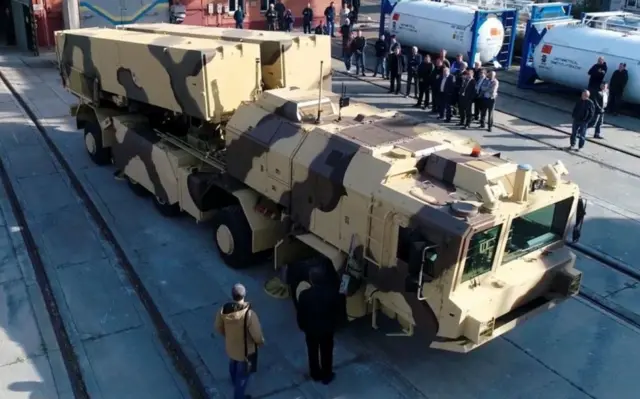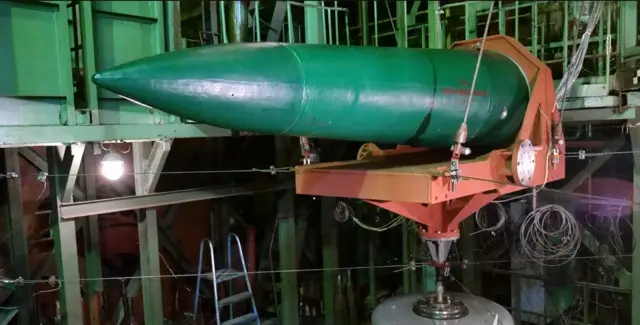On August 27, 2024, during a press conference, President of Ukraine Volodymyr Zelenskyi announced the successful test of the first Ukrainian ballistic missile. This is a significant event for the country's defense sector, which has the potential to radically change the balance of power in the conflict and highlights significant progress in the development of the Ukrainian military industry.
"I thought it was too early to talk about it, but there was already a positive test of the first Ukrainian ballistic missile. I congratulate our Defense Ministry on this," the head of state said, but did not provide details.
According to him, the fact of creating our own ballistics shows the high level of Ukrainian military specialists.
Back in July, Zelenskyi spoke about the "good dynamics" of the Ukrainian missile program.
"Our missile program has good dynamics, and although it is a difficult task, we are gradually approaching the possibility of using our own missiles, and not only relying on supplies from partners."
It is worth noting that the Ukrainian army already has ballistic missiles.
These are the old Soviet "Point-U" complexes, which have a range of only 120 km and a very limited number of missiles. And also the American ATACMS, which hit at a distance of 300 km, but the White House stubbornly forbids Kyiv to use them on Russian territory.
Therefore, the creation of its own long-range ballistic missile has been a priority for the Ukrainian defense industry in recent years.
In order to understand why this is an extraordinary breakthrough, it is necessary to remember what ballistic missiles actually are and why Ukraine could not create them for almost 20 years.
What is a ballistic missile and how is it used
Unlike a cruise missile, a ballistic missile at the final stage attacks the target almost vertically and at high speed, leaving very little chance for air defense to intercept it.
Such missiles can be launched from land-based fixed or mobile launchers, as well as from ships, submarines and aircraft.
Rockets can carry high-explosive, cluster and even nuclear warheads.
By range, ballistics are divided into short range (250-1000 km), medium range (1000-2500-4500 km) and intercontinental range (4500-6000 km).
The power, speed and accuracy of ballistic missiles made them one of the most important types of high-precision weapons in the Russian army.

Photo author, Ministry of Defense of the Russian Federation
Very important targets in the Ukrainian theater of operations and in the rear of the territory are hit by ballistics - most often by "Iskander-M" missiles.
These are powerful missiles 7.2 m long with a warhead of almost 500 kg, flying at the final stage at a speed of 2100 m/s.
That is, Iskander can cover its maximum range (400-500 km) in 5-6 minutes. Given that the Russians launch it from much closer distances, this approach time is even shorter.
The Russians used Iskanders, in particular, for attacks on military airfields in the Poltava, Dnipropetrovsk, and Kirovohrad regions, for attacks on the HIMARS and Patriot missile systems.
Usually, the attacks looked like this: a Russian reconnaissance drone found a target, transmitted its coordinates, and a ballistic missile hit the enemy's object a couple of minutes later.
Frequent and fairly effective use has led to the fact that Russia has probably substantially exhausted its ballistic missile reserves. This forced it to turn for help to North Korea, which provided its missiles and they have already been used several times for attacks on Ukraine.
Shooting down ballistics is one of the most difficult tasks for Ukrainian air defense. The information released by the head of the Armed Forces Oleksandr Syrsky shows that since the beginning of the full-scale war, the Russian Federation has launched 1,300 Iskander ballistic missiles, of which only 56 were intercepted.
So, for the Russian-Ukrainian war, it is ballistics that plays an extremely important role, giving a significant advantage to one of the parties.
Accordingly, the creation of a Ukrainian ballistic missile should be a priority task for the Ukrainian defense industry. The only problem is that he has not been able to do this for the previous 20 years.
History of Ukrainian ballistics
Ukraine thought about creating its own ballistics back in the early 2000s during the presidency of Viktor Yushchenko.
Then it was announced about the development of operational-tactical missile complex (OTRK) "Sapsan", which was actually supposed to become an analogue of the Russian "Iskander". The Ukrainian complex was also supposed to hit at a maximum range of up to 500 km and have a warhead of about half a ton.
This project was planned to be completed in 2012, but the lack of funding pushed back the deadline. It was suddenly stopped during the presidency of Viktor Yanukovych in June 2013.
The then Minister of Defense Pavlo Lebedev announced the complete cancellation of the "Sapsan" project. He is now wanted for treason and, according to preliminary data, is hiding in Crimea, annexed by Russia.
However, already in 2016 it became known about the revival of the "Sapsan" project under the export name "Grim-2". Ukraine apparently started the creation of this OTRK with a range of up to 280 km on the order of Saudi Arabia.
In February 2021, Defense Minister Andriy Taran said that the "Sapsan" is 80% ready and "it is necessary to take the last step" and complete the first sample of this newest weapon.
However, in April of the same year, his deputy Andriy Myronyuk stated that the level of production of the first battery of the OTRK was 70%.

Author of the photo, TSN
This battery was supposed to contain two launchers and charging machines, as well as two control machines, divisional and battery level to conduct the entire set of tests in the shortest possible time.
After the start of a full-scale war, official information about the Ukrainian missile program became even less. At the same time, Russia has already publicly reported several times about the downing of supposedly Ukrainian ballistic missiles "Grim-2".
In addition, in the fall of 2022, Ukrainian law enforcement officers detained an employee of the "Southern" KB on suspicion of espionage. According to the investigation, she gave the Russian special services information about the stage of production of "Sapsan" at her own enterprise.
According to her, as of the summer of 2022, this missile complex was at the stage of readiness and release of the product.

Author of the photo, KB "Pivdenne"
As early as August 2024, military expert and head of the Come Back Alive Foundation Taras Chmut stated in an interview that Ukraine is currently developing three modifications of the Peregrine falcon, but did not reveal how they differ.
"Unfortunately, the state of Ukraine found financing for these complexes only in 2022," he noted.
Military analyst Mykola Beleskov hints that President Zelensky's statement is about the successful test of a ballistic missile for the "Sapsan" complex.
"A little more than 11 years from the cancellation to the successful test," he wrote on Facebook, adding a screenshot of the news about the cancellation of the Sapsan project in June 2013.
However, it should be emphasized that it is still too early to say how successful this development is in combat conditions. Only time will tell. If the Ukrainian ballistic missile turns out to be sufficiently fast, powerful and accurate, then even Moscow may be under threat. The distance from the Russian capital to the Ukrainian border is approximately 460 km.
Pavlo Aksyonov, military commentator of the BBC, about the first Ukrainian ballistic missile
The President of Ukraine, Volodymyr Zelenskyi, announced the test of a Ukrainian ballistic missile two days after it became known that the Ukrainians had created the Palyanitsa cruise missile.
There is nothing surprising in this announcement. Ukraine is a country in which, since Soviet times, there was a developed aviation industry, and large rocket enterprises - KB "LUCH" and "Pivdenmash" worked. Ukraine built airplanes and space rockets.
Even in the conditions of war, when the Ukrainian defense industry is subjected to Russian missile attacks and its work is complicated, specialists and technologies remain in the country. Therefore, the development of a ballistic missile is not completely incredible.
Unlike "Palyanytsia", about which little is known, but at least the range, dimensions and launch system, nothing is known about the ballistic missile. Meanwhile, the missiles of the Soviet "Grad" anti-aircraft missile system, and the more long-range Ukrainian "Alders" and the American MGM-140 ATACMS can be considered ballistic.
If this new missile will be of an operational-tactical class, like "Point U" or ATACMS, and if Ukraine can produce it together with cruise missiles, then their joint use will greatly complicate the situation in the border regions of Russia - a combined attack of several different means of destruction is very difficult repel. In addition, no one will be able to limit the use of these means for the purposes in Russia.
So far, it is difficult to assess the potential of these weapons - almost nothing is known about them, including the degree of readiness and production capabilities. However, it is safe to say that in the conditions of limited Western supplies, Ukrainians are determined to arm themselves.

